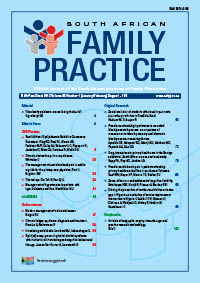Prevalence of end-digit preference in recorded blood pressure by nurses: a comparison of measurements taken by mercury and electronic blood pressure-measuring devices
Keywords:
blood pressure measurement, mercury sphygmomanometer, digital blood pressure-measuring devices, end digit preference.
Abstract
Objectives: When compared with the use of a mercury sphygmomanometer, the use of a validated digital blood pressure (BP) measuring device eliminates the risk of exposure to mercury. Digital devices are also associated with a lesser degree of end-digit preference (EDP). EDP refers to the occurrence of a particular end digit more frequently than would be expected through chance alone. There have been only a few reports from Africa on the occurrence of EDP in BP measurement. This study examined EDP in BP taken by nurses before and after the introduction of a digital BP-measuring device. Design: The design was a retrospective study. Settings and subjects: We reviewed the BP readings of 458 patients who presented at the dedicated clinic for people living with human immunodeficiency virus/acquired immune deficiency syndrome of Ladoke Akintola University of Technology Teaching Hospital, Osogbo, Nigeria, before and after the introduction of the digital BP-measuring device. Outcome measures: The prevalence of end-digit zero of systolic and diastolic BP readings before and after the introduction of the digital device was compared using McNemar’s test. Results: There was a large and significant fall in end-digit zero when BP readings that were taken using the mercury and digital devices were compared (systolic 98.1% vs. 10.9%, p-value < 0.001; diastolic 97.1% vs. 14.9%, p-value < 0.001 (McNemar’s test). Conclusion: There was a significant reduction in the frequency of end-digit zero when BP was taken with the digital device rather than the mercury device. Regular training and certification of healthcare workers in BP measurement is recommended to ensure a high quality BP measurement standard.
Published
2012-08-06
Section
Original Research
By submitting manuscripts to SAFP, authors of original articles are assigning copyright to the South African Academy of Family Physicians. Copyright of review articles are assigned to the Publisher, Medpharm Publications (Pty) Ltd, unless otherwise specified. Authors may use their own work after publication without written permission, provided they acknowledge the original source. Individuals and academic institutions may freely copy and distribute articles published in SAFP for educational and research purposes without obtaining permission.

